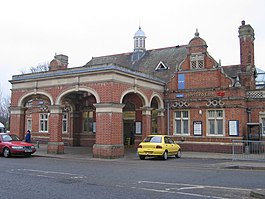Hertford East railway station
| Hertford East | |
|---|---|
 The main entrance to the station | |
| Location | Hertford |
| Local authority | District of East Hertfordshire |
| Grid reference | TL330129 |
| Managed by | Greater Anglia |
| Station code(s) | HFE |
| DfT category | E |
| Number of platforms | 2 |
| Accessible | Yes[1] |
| Fare zone | B |
| National Rail annual entry and exit | |
| 2014–15 | |
| 2015–16 | |
| 2016–17 | |
| 2017–18 | |
| 2018–19 | |
| Railway companies | |
| Original company | Great Eastern Railway |
| Pre-grouping | Great Eastern Railway |
| Post-grouping | London and North Eastern Railway |
| Key dates | |
| 27 February 1888 | Opened as Hertford |
| 1 July 1923 | Renamed Hertford East |
| Other information | |
| External links | |
| Coordinates | 51°47′56″N 0°04′23″W / 51.799°N 0.073°W |
Hertford East railway station is the northern terminus of the Hertford East branch line off the West Anglia Main Line in the east of England, and is located in the town of Hertford in Hertfordshire. It is 24 miles 19 chains (39.0 km) down the line from London Liverpool Street and is one of two stations in the town, the other being Hertford North on the Hertford Loop Line. Its three-letter station code is HFE.
The station and all trains calling are operated by Greater Anglia.
There are two platforms, although platform number one is generally only used during peak times, during times of disruption and primarily for trains to and from Stratford station.
History
The current station, designed by W. N. Ashbee, was opened by the Great Eastern Railway on 27 February 1888, replacing a station further to the east which dated from the opening of the branch line from Broxbourne in 1843. The station was listed in 1974 as a Grade II* listed building;[3] in 1996 the buffer stop lights on platform 1 were separately listed in their own right.[4]
Services

The typical Monday-Saturday off-peak service is two trains per hour to London Liverpool Street via Tottenham Hale.
The typical morning peak service is three trains per hour, two of which are for Liverpool Street via Seven Sisters and one is for Stratford via Tottenham Hale. The typical evening peak service is three trains an hour, two of which are for Liverpool Street via Tottenham Hale and one of which is for Broxbourne.
The typical service on a Sunday is two trains per hour to Stratford via Tottenham Hale. .
Services are generally formed of Class 317 trains, however in times of disruption Class 379 units are sometimes used.
Oyster cards are accepted at the station.

Proposed developments
Some options of the proposed East West Rail involve reopening a route between Hertford East railway station and Hertford North railway station; however a 2009 discussion paper noted that while "the new connection appears technically feasible, doubts must be cast over its public acceptability and deliverability".[5]
References
- ^ "Hertford East (HFE)". National Rail Enquiries. Archived from the original on 23 August 2017.
- ^ a b c d e "Estimates of station usage". Rail statistics. Office of Rail Regulation. Please note: Some methodology may vary year on year.
- ^ "Hertford East Station". British Listed Buildings Online. English Heritage.
- ^ "Buffer Lights On Platform 1 at Hertford East Station". British Listed Buildings Online. English Heritage.
- ^ "East West Rail Central Section - Operating Case Discussion Paper" (PDF). Archived from the original (PDF) on 12 December 2013. Retrieved 6 December 2013.
External links
- Train times and station information for Hertford East railway station from National Rail
| Preceding station | Following station | |||
|---|---|---|---|---|
| Greater Anglia | Terminus | |||
- Rail transport stations in London fare zone B
- DfT Category E stations
- Railway stations in Hertfordshire
- Former Great Eastern Railway stations
- Railway stations in Great Britain opened in 1888
- Greater Anglia franchise railway stations
- Buildings and structures in Hertford
- Grade II listed railway stations
- William Neville Ashbee railway stations

